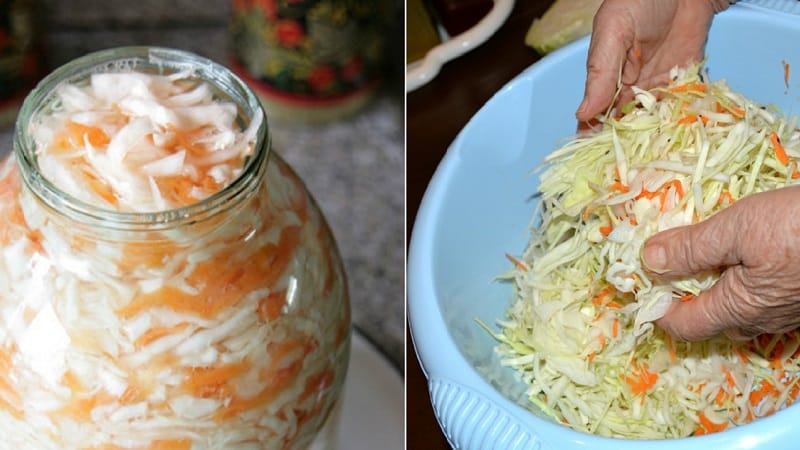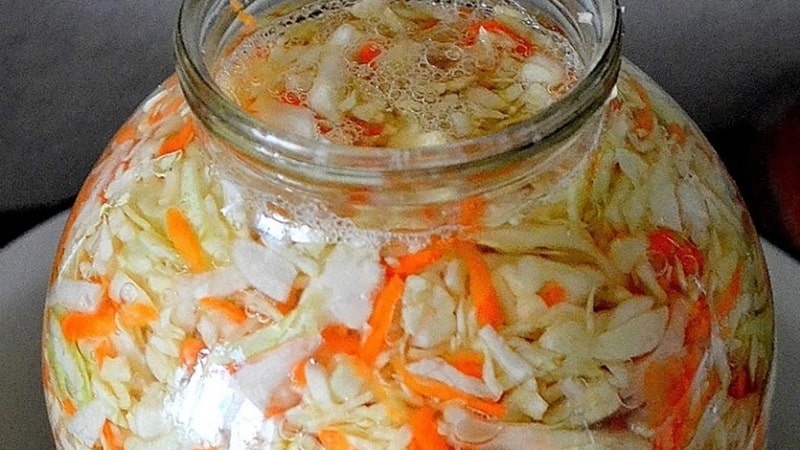What to do if there is not enough brine in sauerkraut and why this could happen
Sauerkraut is one of the favorite snacks on the Russian table. The process of its creation resembles an entire art, full of subtleties and secrets. But what to do if there is not enough brine in the jar of sauerkraut? Will we really have to start everything over again and chop up a new head of cabbage?
Let's figure out how to save the cabbage from drying out and fill the jar with new juice. We will also give some tips on how to avoid this problem in the future.
What are the consequences of a lack of brine in sauerkraut?
The brine should cover the cabbage completely. Only then will it ferment to the desired crispy, sour state. If there is a lack of liquid, the product will, at best, simply dry out, and at worst, it will become rotten and become unsuitable for food.
Important! Keep an eye on the preparations: if the cabbage sits without brine for the second day, it can no longer be saved. The only option is to simmer it in a pan with oil.
Why there may be little brine in sauerkraut
If the cabbage does not produce juice when fermented, little brine is obtained. There are several reasons for this.
Unsuitable cabbage variety
You could have made the wrong choice of variety or harvested the heads of cabbage too early. It is best to ferment varieties of white cabbage: Moskovskaya late, Rusinovka, Mara, Snezhinskaya, Belorusskaya-85, Yubileynaya-29, Nadezhda, Amager, Kolobok, Podarok and - the most popular - Slava.
Choose a head of cabbage that ripens in late autumn - late October or November, after the first frost. It is at this time of year that a lot of natural sugar is formed in the vegetable, which is needed to release lactic acid - thanks to it, the cabbage will ferment well in the jar.

Important! To determine if a head of cabbage is suitable, look at its leaves. The whiter they are, the more sugar it contains and the more suitable it is for fermentation. It is best if there are no green leaves at all. Another way is to cut the head of cabbage in half. The cut should be white and the leaves should be crispy and sweet.
Errors during fermentation
Do not neglect salt when fermenting - it is needed to release liquid. But you shouldn’t get carried away with it, otherwise it will interfere with the process of lactic acid fermentation. Put it within 20-25 g per 1 kg of cabbage.
If you have not made a mistake with the quantity, after a day the entire contents of the jar should be immersed in the brine. Otherwise, you may lose all the beneficial substances of the vegetable, and the product will simply rot.
Important! Use regular coarse salt. Iodized cabbage softens the cabbage.
What to do, how to increase the amount of brine
If the cabbage has been standing long enough to release juice, but there is clearly not enough juice in the jar, this is not a reason to refuse pickling.

What to do if the cabbage does not give juice
Some housewives do not spare cabbage, and the part that lay on top without brine is simply thrown away, and the part that is soaked in juice is sent back under oppression. This is a sacrifice of quantity of a product for the sake of its quality - not everyone likes the taste of the product if, for example, you make your own brine and add it to a jar (more on this below).
If there is no juice, perhaps the reason is that the pressure is too light. It is worth adding weight to squeeze out more liquid. If nothing works out and you feel sorry for throwing away dry cabbage, make the brine yourself.
Interesting things on the site:
What is the best salt to use for cabbage?
How to make brine if there is not enough of it
If you do not plan to store the workpiece for a long time, you can add homemade brine into the container.
Make it according to the recipe:
- Pour 1 liter of water into a saucepan and bring it to a boil.
- When the water boils, turn off the gas and add 1 tbsp. l. salt.
- Wait until the water cools down. When you can dip your finger into the water, add 1 tbsp. l. Sahara.
- The brine will be completely ready when it cools to room temperature. Now it can be poured into the container.
This cabbage can be stored for no more than three weeks. at a temperature not higher than +4°C.
How to ferment cabbage correctly so that there is enough brine
So that the juice is released in sufficient volume and the cabbage does not come out dry, follow the correct salting order:
- Do not wash the forks before chopping, but only remove any green or rotten leaves.
- Then cut the head of cabbage into 2-3 parts and chop.
- Take regular coarse salt, but not iodized. If you put too much of it, it can stop the fermentation process and nothing will come out. Optimally – 20-25 g per 1 kg of product.
- Place two whole cabbage leaves, generously sprinkled with salt, on the bottom of the jar to soften.
- Before fermenting, remember the chopped cabbage with your hands or a rolling pin, and after you put everything in the container, press it harder inside with your fist so that the juice begins to come out.
- If you ferment in a saucepan, you will have to weigh down the raw materials with something heavy. Place a plastic napkin on top, a plate or wooden grid on it, and pressure on top of everything. It could be a scalded cobblestone or a plastic canister filled with water.Metal objects - weights, barbell discs - and bricks cannot be used as oppression.
- If you have a three-liter jar, you can use the bag trick. Take a simple plastic food bag, fill it halfway with water, release the air, and tie it at the end. Then gently push it into the neck, and the weight of the water will press the cabbage.
- Fermentation will begin after a few hours, when foam forms on top. You will have to constantly clean it and make sure it doesn’t leak onto the floor. At first there will be a lot of it, then less and less. As soon as you notice that it is no longer there, you can try - everything is ready.
- At the end, you will have to pierce the cabbage with a wooden stick to the very bottom or stir it. This is to release gases that may cause the product to taste bitter.
- On average, cabbage ferments for about a week.

Features of pickling non-juicy heads of cabbage
If you are late in harvesting cabbage, it may freeze and dry out.. When pickling, it will be very difficult to obtain the required amount of juice from such heads of cabbage, and you will have to prepare the brine separately in any case.
Additionally, to help the vegetable ferment, you can add carrots, cranberries or Antonov apples.
Read also:
Tips and tricks on the topic
A few additional tips will help preserve the benefits and extend shelf life. product:
- Follow the cabbage storage regime and do not freeze it so as not to lose its beneficial properties. The optimal storage temperature in the refrigerator is 0...+2°C.
- Ferment cabbage in wide saucepans or basins. The larger the area of contact with air, the better the fermentation process.
- Do not add vinegar if you want to preserve the beneficial properties of the product.
- Don't add onions to the cabbage to give it extra flavor. This kind of pickling will not last for a long time.
Conclusion
So, the main points of cabbage starter. You need to take heads of cabbage of certain varieties; Slava is best suited for this. To achieve a sufficient amount of juice, the cabbage will have to be thoroughly mashed and compacted into a container. Do not skimp on salt, but do not get carried away with it - 25 g per 1 kg of product is quite enough.
If not enough juice has been released, prepare the brine separately and add it to the container so that it covers the entire contents. The workpiece should ferment for five days under pressure - a scalded stone or a jar of water. Follow the recipe, then this delicious snack will delight you all winter.